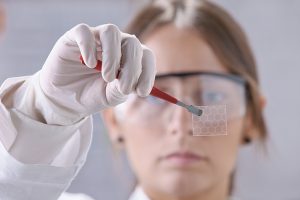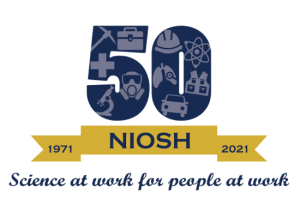National Nanotechnology Day: A big day for small things
Posted on by
Every year on October the 9th we celebrate National Nanotechnology Day. The date 10-9 pays homage to the nanometer scale: 10-9. Anything that can be measured in nanometers (nm) is extremely small! For instance, bacteria can be between 300-5,000 nm, a virus can be 5-300 nm, the diameter of deoxyribonucleic acid (DNA) is 2.5 nm, and a single atom is 0.1-0.5 nm. A healthy young adult’s fingernail grows an average of just over one nanometer per second (3.47 mm per month average)!1 National Nanotechnology Day was created to help raise awareness of nanotechnology, how it is currently used in products that enrich our daily lives, and the challenges and opportunities it holds for the future.
Engineered nanomaterials (ENMs) are materials that are intentionally produced to have at least one primary dimension less than 100 nanometers. These materials have new or unique properties different from those of larger forms of the same material, making them desirable for specific product applications. These properties can contribute to increased elasticity, tensile strength, electrical conduction, and reactivity. Consumer products using nanomaterials include makeup, sunscreen, food storage products, appliances, clothing, electronics, computers, sporting goods, and coatings. In addition, nanomaterials have been used in a variety of applications, such as medicine (targeted therapy and identification of cancerous cells), electronics (integrated circuits, memory, and speed), robotics (decreased size), and defense (bulletproof materials). ENM researchers have made use of and studied naturally occurring nanomaterials in order to increase our knowledge of the world around us and create new and exciting products. Nanomaterial science is an extremely innovative science with diverse applications and great opportunities!
As with every new technology, the potential risks need to be considered in addition to the benefits. NIOSH has been at the forefront of efforts to characterize the potential hazards for those working with ENMs and ensure safe workplaces since the early 2000’s including the creation of the NIOSH Nanotechnology Research Center in 2004. Earlier this year (May 2021), NIOSH published risk assessment documentation and a recommended exposure limit (REL) for silver nanoparticles.2 The REL for silver (Ag) nanoparticles (<100 nm primary particle size) is 0.9 µg/m3 as an airborne respirable 8-hour TWA concentration. NIOSH continues to recommend a REL of 10 µg/m3 as an 8-hour TWA for total silver (metal dust, fume, and soluble compounds, as Ag). NIOSH has previously published RELs for nanoscale titanium dioxide and carbon nanotubes/carbon nanofibers in 2011 and 2013 respectively.3,4
Exposure assessment and control verification can be performed to determine the potential for workplace exposure to engineered nanomaterials. The NIOSH Nanomaterial Exposure Assessment Technique (NEAT 2.0) can be used to identify the potential for exposure to a workplace engineered nanomaterial. NEAT 2.0 makes use of an array of industrial hygiene methods including filter-based samples and particle counters.5,6 In addition, the poster, Controlling Health Hazards when Working with Nanomaterials: Questions to Ask Before you Start is a helpful visual resource for use in the workplace.7
Nanotechnology research efforts have expanded into emerging technologies, such as 3-dimensional (3D) printer materials. Now, nanoscale science not only applies to the materials and the use of the materials, but also to the manipulation of materials at the nanoscale. For instance, embedding nanomaterials into 3D printed composites can enhance the properties of these complex parts, extending composite capabilities for electrical/thermal gradients, increasing strength, and decreasing overall weight.8,9 3D printing of nanocellulose hydrogels is being used in biomedical applications to support living cell growth for tissue engineering, implants, and cardiovascular devices.10 Additionally, Nano-3D printing has been used to create nanoscale surface changes on printed cell substrates that increase the growth of osteocytes (bone growth).11 As workers are the first to be exposed to new and emerging technologies, NIOSH has continued to provide guidance to keep workers safe. During the past year NIOSH published two workplace posters: 3D Printing with Metal Powders: Health and Safety Questions to Ask and 3D Printing with Filaments: Health and Safety Questions to Ask.12,13 NIOSH also published the first paper describing an engineering control for 3D printers which studies show can reduce ultrafine particle concentrations from an individual printer by 98%.14
We hope you find a way, even if it is a very small way, to celebrate National Nanotechnology Day! The National Nanotechnology Initiative (nano.gov) suggests a 100-Billion Nanometer Dash. This would be 100 meters (328 feet) and the equivalent of 6.2% of a mile! Good luck on your nanometer dash and feel free to post your times in the comment section below! NIOSH will continue to support your safety and  health within the nanomaterial workplace.
health within the nanomaterial workplace.
This blog is part of a series for the NIOSH 50th Anniversary. See the Nanotechnology webpage for more information on how NIOSH has protected workers from the risks of nanomaterials for nearly 20 years. Stay up to date on how we’re celebrating NIOSH’s 50th Anniversary on our website.
Laura Hodson, MSPH, CIH, FAIHA, is the Deputy Branch Chief of the NIOSH Division of Science Integration Emerging Technologies Branch.
Adrienne Eastlake, MS, RS/REHS, MT (ASCP), is an industrial hygienist in the Nanotechnology Research Center within the NIOSH Division of Science Integration Emerging Technologies Branch.
References
- Yaemsiri S, Hou N, Slining MM, He K. [2010] Growth rate of human fingernails and toenails in healthy American young adults. J Eur Acad Dermatol Venereol. Apr;24(4):420-3. https://doi.org/10.1111/j.1468-3083.2009.03426.x
- NIOSH [2021]. Current intelligence bulletin 70: health effects of occupational exposure to silver nanomaterials. By Kuempel E; Roberts JR; Roth G; Dunn KL; Zumwalde R; Drew N; Hubbs A; Trout D; Holdsworth G. Cincinnati, OH: U.S. Department of Health and Human Services, Public Health Service, Centers for Disease Control and Prevention, National Institute for Occupational Safety and Health, DHHS (NIOSH) Publication No. 2021-112, 2021 May; :1-332. https://www.cdc.gov/niosh/docs/2021-112/
- NIOSH [2011]. Current intelligence bulletin 63: occupational exposure to titanium dioxide. By Dankovic-D; Kuempel-E; Geraci-C; Gilbert-S; Rice-F; Schulte-P; Smith-R; Sofge-C; Wheeler-M; Lentz-TJ; Zumwalde-R; Maynard-A; Attfield-M; Pinheiro-G; Ruder-A; Hubbs-A; Ahlers-H; Lynch-D; Toraason-M; Vallyathan-V. Cincinnati, OH: U.S. Department of Health and Human Services, Public Health Service, Centers for Disease Control and Prevention, National Institute for Occupational Safety and Health, DHHS (NIOSH) Publication No. 2011-160, (CIB 63), 2011 Apr; :1-119. https://www.cdc.gov/niosh/docs/2011-160/
- NIOSH [2013]. Current intelligence bulletin 65: occupational exposure to carbon nanotubes and nanofibers. By Zumwalde R; Kuempel E; Birch E; Trout D; Castranova V Cincinnati, OH: U.S. Department of Health and Human Services, Public Health Service, Centers for Disease Control and Prevention, National Institute for Occupational Safety and Health, DHHS (NIOSH) Publication No. 2013-145, (CIB 65), 2013 Apr; :1-156 https://www.cdc.gov/niosh/docs/2013-145/
- Eastlake A, Beaucham C, Martinez K, Dahm M, Sparks C, Hodson L, Geraci C [2016]. Refinement of the Nanoparticle Emission Assessment Technique into the Nanomaterial Exposure Assessment Technique (NEAT 2.0), J Occup Environ Hyg 2016 Sep; 13(9):708-717, http://dx.doi.org/10.1080/15459624.2016.1167278
- Brenner S, Neu-Baker N, Eastlake A, Beaucham C, Geraci C [2017] NIOSH field studies team assessment: worker exposure to aerosolized metal oxide nanoparticles in a semiconductor fabrication facility, J Occup Environ Hyg 2016 Nov; 13(11):871-880, https://doi.org/10.1080/15459624.2016.1183015
- NIOSH [2018]. Controlling Health Hazards when Working with Nanomaterials: Questions to Ask Before you Start. Cincinnati, OH: U.S. Department of Health and Human Services, Public Health Service, Centers for Disease Control and Prevention, National Institute for Occupational Safety and Health, DHHS (NIOSH) Publication No. 2018-103, 2018 Feb; :1. https://www.cdc.gov/niosh/docs/2018-103/
- Campbell T, Ivanova OS [2013] 3D printing of multifunctional nanocomposites, Nano Today, 8(2);119-120, https://doi.org/10.1016/j.nantod.2012.12.002.
- Sezer HK; Eren O [2019] FDM 3D printing of MWCNT reinforced ABS nano-composite parts with enhanced mechanical and electrical properties, Journal of Manufacturing Processes, 37:339-347, https://doi.org/10.1016/j.jmapro.2018.12.004
- Sultan S; Siqueira G; Zimmermann T; Mathew AP [2017]. 3D printing of nano-cellulosic biomaterials for medical applications, Current Opinion in Biomedical Engineering, 2:29-34 https://doi.org/10.1016/j.cobme.2017.06.002
- Greer AIM, Barbour E, Cutiongco MF, Stormonth-Darling JM, Convery N, Alsaigh RE, Lavery MPJ, Gadegaard N [2020] Large volume nanoscale 3D printing: Nano-3DP, Applied Materials Today, 21:100782, https://doi.org/10.1016/j.apmt.2020.100782
- NIOSH [2020a]. 3D printing with metal powders: Health and safety questions to ask. By Glassford E, Dunn KL, Dunn KH, Hammond D, Tyrawski J. Cincinnati, OH: U.S. Department of Health and Human Services, Centers for Disease Control and Prevention, National Institute for Occupational Safety and Health, DHHS (NIOSH) Publication No. 2020- 114, https://www.cdc.gov/niosh/docs/2020-114/
- NIOSH [2020b]. 3D printing with filaments: Health and safety questions to ask. By Glassford E, Dunn KL, Dunn KH, Hammond D, Tyrawski J. Cincinnati, OH: U.S. Department of Health and Human Services, Centers for Disease Control and Prevention, National Institute for Occupational Safety and Health, DHHS (NIOSH) Publication No. 2020-115, https://www.cdc.gov/niosh/docs/2020-115/
- Dunn KL; Hammond D; Menchaca K; Roth G; Dunn KH [2020]. Reducing ultrafine particulate emission from multiple 3D printers in an office environment using a prototype engineering control. J Nanoparticle Res 2020 May; 22(5):112 https://doi.org/10.1007/s11051-020-04844-4
Posted on by

